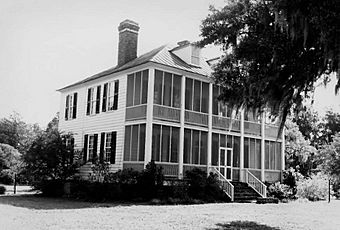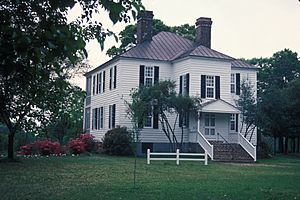Hopsewee facts for kids
|
Hopsewee
|
|

Hopsewee as it looked in 1971.
|
|
| Nearest city | Georgetown, South Carolina |
|---|---|
| Built | 1735 |
| NRHP reference No. | 71000782 |
Quick facts for kids Significant dates |
|
| Added to NRHP | January 25, 1971 |
| Designated NHL | November 11, 1971 |
Hopsewee Plantation is a historic home built in 1735 near Georgetown, South Carolina. It was the main house of a large rice plantation. The house is famous for being the birthplace of Thomas Lynch, Jr.. He was one of the Founding Fathers who signed the Declaration of Independence.
Hopsewee was a working rice plantation. This meant that many people were forced to work there. These people were enslaved African Americans, who were treated as property under the laws of that time. Thomas Lynch, Jr. owned more than 250 enslaved people who worked on his plantations.
The house is also known as the Thomas Lynch, Jr., Birthplace or Hopsewee-on-the-Santee.
Contents
The Story of Thomas Lynch, Jr.
Thomas Lynch, Jr. was an important figure in American history. As a young man, he became involved in the American Revolution. He was chosen to represent South Carolina and signed the Declaration of Independence. This famous document declared that the American colonies were free from British rule.
In 1779, Lynch became very sick. He and his wife decided to travel to the West Indies to try and get better. Before they left, he wrote a will. A will is a legal document that says who gets your property after you die. Lynch's will said that any family members who inherited his land had to change their last name to Lynch.
Sadly, the ship that Lynch and his wife were on disappeared during a storm at sea. They were never seen again.
History of the House
The Lynch family sold Hopsewee in 1752 to a man named Robert Hume. The house was passed down through the Hume family for many years. Like many plantations in the area, Hopsewee was abandoned during the Civil War. After the war, the family returned but never grew rice there again. The Hume-Lucas family owned the house until 1925.
In 1949, Colonel and Mrs. Wilkinson bought Hopsewee and lived in it. Because of its history, the house was declared a National Historic Landmark in 1971. This is a special title for places that are important to American history.
Architecture and Design
What Does Hopsewee Look Like?
Hopsewee is a great example of a "low country" plantation house. This style was common in coastal South Carolina and was influenced by designs from the West Indies. A key feature is the two-story porch, called a "piazza," that wraps around the house.
The house is built from black cypress wood and sits on a brick foundation. The main house is 40 feet wide and 50 feet deep. Inside, each floor has a large central hallway with four rooms branching off from it. The piazzas you see today were added around 1845.
Visiting Hopsewee Today
Hopsewee is located about 13 miles south of Georgetown, near the North Santee River. Although it is still a private home, it is open to the public for tours.
Inside, you can see furniture from the 18th and 19th centuries. Visiting the house is like taking a step back in time. It helps people learn about the history of South Carolina and the United States.
See also




